

How Can Students Self-Assess When Teachers Do All the Grading and Work? “It wasn’t really moving the needle in terms of their skill set,” said Tucker.
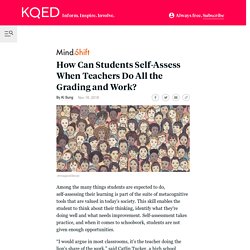
“And I recognized that instead of putting 90 percent of my energy into assessing and giving feedback on a finished product, I need to put that 90 percent of my energy into giving them feedback as they work.” She found that when students get feedback as part of the process of completing an assignment, it gives kids the opportunity to revise their work. The feedback process mans that students must be in constant communication with Tucker about their work. This is in addition to keeping track of what they think they’ve learned through post-lesson reflection tools like learning logs and sketchnotes. Grades Are a Journey in Tucker’s Class Tucker, who is an instructional coach and the author of several books on blended learning, applied these strategies to a program at Windsor High School when she was a teacher there. She also encourages teachers to involve students in a meaningful way in the final grade. Should high school students have to 'defend' their diploma like a Ph.D? LOS ANGELES — Looking smart in a blue button-down shirt, Jorge Magana, 18, zipped through a PowerPoint presentation with the confidence of a Fortune 500 CEO.
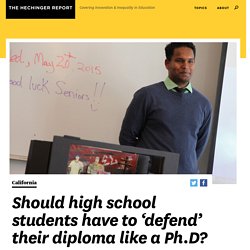
Seated in front of Magana in a classroom at Los Angeles High School of the Arts was a panel of three judges: the school’s assistant principal, a school coordinator, and a former student. The occasion was his senior defense. Magana was trying to convince the panel that he was ready to graduate. He had 45 minutes to present a portfolio of three “artifacts,” one academic, one artistic, and one of his own choosing. The panel grilled him: Can you describe your research process? Portfolio assessments like this one, which look a lot like doctoral dissertation defenses, are on the rise in California.
Since 1999, California has primarily tied school rankings to test scores, using the Academic Performance Index (API). Related: Stakes for “high-stakes” tests are actually pretty low Magana’s presentation seemed to come off smoothly. Defense portfolio rubric. Digital Portfolio Collection, Display, and Feedback System. When students take the time to create and curate digital portfolios, they are connecting more meaningfully to what they are learning and how they are learning it.
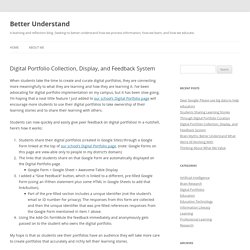
I’ve been advocating for digital portfolio implementation on my campus, but it has been slow going. I’m hoping that a neat little feature I just added to our school’s Digital Portfolio page will encourage more students to use their digital portfolios to take ownership of their learning stories and to share their learning with others. Students can now quickly and easily give peer feedback on digital portfolios! In a nutshell, here’s how it works: Students share their digital portfolios (created in Google Sites) through a Google Form linked at the top of our school’s Digital Portfolio page. Website design rubric. Authentic Assessment Toolbox. Portfolios What is a Portfolio?
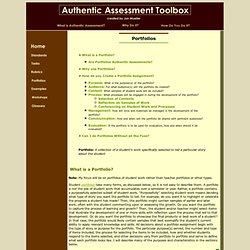
Personal Goals: An Exercise in Student Self-Assessment. This summer I am reading Linda Nilson’s book Creating Self-Regulated Learners: Strategies to Strengthen Students’ Self-Awareness and Learning Skills, which offers instructors a wealth of assignments and activities to help students grow their self-regulation and metacognitive abilities.
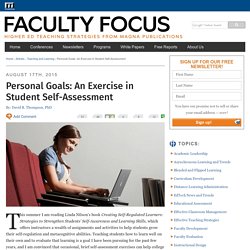
Teaching students how to learn well on their own and to evaluate that learning is a goal I have been pursuing for the past few years, and I am convinced that occasional, brief self-assessment exercises can help college students perform better as well as understand the learning process. I teach Spanish, and over the years I’ve noticed that as language students move to higher levels of the curriculum and higher levels of proficiency, they are able to identify the content (grammar, vocabulary) and skills (narration, speculation, speaking on abstract topics) that are most challenging to master. But despite their increasing language proficiency, they are still novices when it comes to self-regulated learning. The Importance of Assessment AS Learning. Lately, I have been focusing on “common assessments” versus “common understandings.”

I have written about this in the past and shared the following ideas on why “common assessments” do not necessarily do what they hope they do.” So here is where I struggle with this concept of “common assessments”. If teacher A does not work with classroom B, do they know the students in that room? Do they know that some of the students have test anxiety, or English is not their first language, or are a myriad of other factors that might not be conducive to “common assessments”? Now there is a difference between wanting students to have the same test, or the same understandings of material. A big question that I focused on from the post: The focus here is that we have to look at “assessment” as part of the learning, not just a summary of learning.
These definitions of “assessment for, as, and of learning” from the New South Wales (Australia) Education Standards Authority, is a good starting point: 12 Must-Read Articles About Assessment -